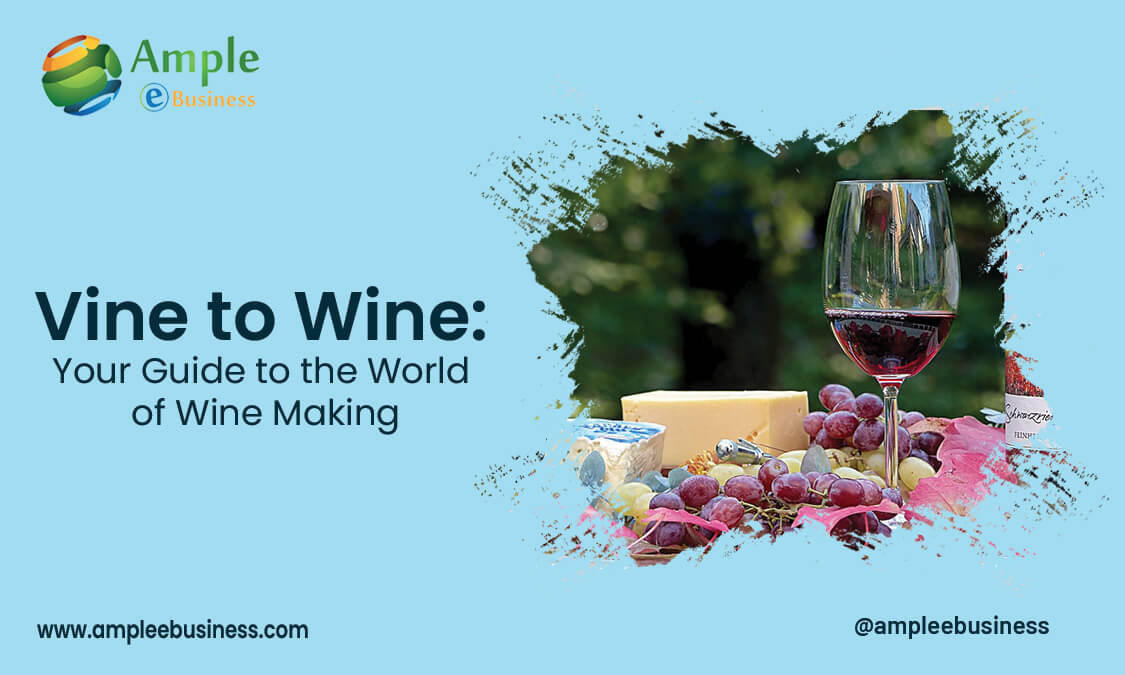
The fascinating and complex process of winemaking turns grapes into the delicious nectar we know as wine. It produces a wide variety of flavours, aromas, and textures by fusing the science of fermentation with the art of grape cultivation. Winemakers use a variety of techniques to extract the juice, which is then fermented with the help of yeast after being carefully chosen and harvested at its peak ripeness.
Grape sugars are magically transformed into alcohol during the fermentation process, creating the wine’s base. The wine undergoes ageing along the way, frequently in stainless steel or oak barrels, where it develops and ages, gaining complexity and nuance. Throughout the process, winemakers expertly balance and blend various wines to produce distinctive expressions of flavour. Let us dive into this wonderful topic of winemaking and let us be your guide to the world of winemaking.
Your Guide to the World of Wine Making
Welcome to the fascinating world of winemaking, where grapes are transformed into fine wines. This guide will introduce you to the fascinating process of making your own wines, whether you’re a passionate enthusiast or an aspiring winemaker.
1) The grapes
The juice and skins of the grapes from the vineyard contain the potential for the finished wine. In order for the task of making wine to be worthwhile in the first place, the raw materials that the winemaker uses must be healthy and balanced. Many winemakers will tell you that it is possible to make bad wine from good grapes, but impossible to make good wine from bad grapes.
2) Harvest
The fruit of a year’s worth of labour (to make sure the grapes are given everything they require to ripen healthily) and crossing fingers for the necessarily favourable weather is the harvest.
The most crucial choice of all, assuming everything has gone according to plan up to this point, is when to pick. Timing is everything, and weather can still wreck everything right up until the last second.
When the grower is confident that the grapes have reached physiological ripeness—that is, have the ideal balance of sugar, acidity, and flavour—or when the whims of nature dictate that picking must be completed before inclement weather arrives, the choice will be made.
3) Through the Winery
Depending on the colour and style of wine being produced, the grape’s journey from the sorting table to the bottle varies significantly. The sorting table, also known as the selection table, is a conveyor belt along which the grapes move while being carefully inspected by a number of pairs of watchful eyes and hands. These individuals look for and remove any rotten or unripe grapes, as well as leaves and other debris that has left the vineyard.
Although some producers of red wines prefer to leave the bunches of grapes intact for the fermentation, stems may also be removed at this point. Whole-bunch fermentation can occasionally result in more distinctive wines (many great Burgundy domaines favour it for their pinot noir, for example).
4) Earlier than fermentation
The winemaker may need to consider the following before adding the grapes to the fermenting container:
a) Pressing
With the exception of a few “free run” wines, red wine grapes will be pressed after fermentation, but almost all white wine grapes are pressed before fermentation. In order for the juice to be fermented, this separates the skins from the juice.
b) Oxygen sulphide
Of course, the devil himself was cast into a sulphur lake that was on fire, but for the majority of winemakers, SO2 is a necessity rather than a punishing evil. It is a crucial preservative that can be used both before and after fermentation and is considered by many to be essential.
It can be used to eliminate the bacteria on the grape skins prior to fermentation.
It is added to the wine after fermentation to stop oxidation and eliminate any remaining yeasts or bacteria.
c) Fermentation
Fermentation can start after the winemaker has taken into account any required and permitted enrichments and, in the case of white wines, pressed the grapes.
By interacting with yeast, fermentation turns the grapes’ natural sugars into alcohol.
5) The vat
Several materials can be used to create fermentation vessels, but concrete, stainless steel, and oak are the most popular choices. Each has advantages for various types of wine. While fermenting wine in stainless steel vats preserves the crispness and freshness so desirable in many livelier-tasting wines, fermenting wine in oak, for example, adds a creamy richness to the finished wine (such as a richly flavorful white Burgundy).
6) Beginning the fermentation
Due to the natural or “wild” yeasts that are present in the grapes and in the winery, the majority of grapes will start to ferment naturally once they are put into a fermentation vessel and crushed. Cultured yeasts are occasionally added, usually in powder form. As a result, the winemaker has more control over the procedure.
7) Red wine: pumping over and punching down
The skins of red grapes must be kept in contact with the juice as much as possible in order to support the growth of the yeasts and add colour and tannin to the wine. In some ways, this is similar to how coffee grounds must remain in contact with water in order to produce a finished brew.
8) Put an end to fermentation
When the winemaker feels the wine has reached the ideal level of alcohol and sweetness, the fermentation is stopped on purpose. Yeasts can be removed via filtration or by adding sulphur dioxide.
On the other hand, a “stuck” fermentation is an unfortunate accident that can happen if the heat generated during the process is not properly controlled or if there are not enough nutrients or yeasts.
9) Lactic acid fermentation
The second fermentation of red and some white wines is carried out by lactic bacteria, which change the harder malic acid (found in apples) into the softer lactic acid (found in milk). Before adding any sulphur dioxide, the temperature of the vat is raised to achieve this. The “malolactic” fermentation, also known as “malo,” produces a wine with a softer texture, less acidity, and more buttery and nutty flavours.
10) ‘Wine Into Wood’ Maturation
After that, the winemaker might choose to age the wine in oak barrels before bottling it. Although there are some notable exceptions, like Riesling, the majority of fine wines throughout the world go through some type of oak ageing. In general, this can result in three positive outcomes:
Flavours: New oak barrels can give the wine nutty, buttery, or vanilla flavours. Examples include the cedary flavour of fine white Burgundy or the creamy, hazelnut characteristics of top Bordeaux.
Oxygen: In some circumstances, the presence of oxygen is required to soften the tannins (add texture to the wine) and give the wine more complex flavours.
Structure: The wood’s influence can occasionally be more subtle, consisting merely of tannins that give the wine more stability.
11) The last touches before bottling
Before the finished wine is bottled, the winemaker still has a few additional optional treatments to think about. These can be applied to stop wine from spoiling or to guarantee that it gets to the consumer’s glass sparkling and clean. The processes that make it possible run the risk of depriving the wine of some of its flavour, complexity, and character, despite the fact that the latter are aesthetically pleasing and considered by some winemakers to be essential.
Because of this, some vintners opt to bottle their wines unfiltered and/or unfined. Although wines can have a lot of personality, they frequently have a “hazy” appearance in the glass. Some could very well settle out in a safe way.
12) Bottling
Now that the wine is finished, it’s time to head to the bottling line. While some cellars use equipment that can be rented, many have their own bottling lines. Even though the wine is finished at this point, bottling is an important step that can still go horribly wrong if it is not done properly.
To prevent spoilage, it’s important to create a sterile and hygienic environment; bottles and other equipment should be spotless. The temperature is also crucial. The majority of wines rely on a cool temperature to prevent any unpleasant microbiological surprises, although some less expensive wines may be “hot-bottled” (a crude form of pasteurisation carried out at the very end).
When to Drink and the Bottle’s Age
The only decision left to make is when to begin selling the wine after it has been bottled. ‘Immediately’ is the most common response in most circumstances. However, some producers keep their wines in their cellars for a while before releasing them to the market, ensuring that the consumer gets them at a point when they are ready to drink! This is because many fine wines benefit from bottle age.
The wine must be able to age, and the producer must have the financial means to carry out this admirable but costly task.
The wine must be able to age, and the producer must have the financial means to carry out this admirable but costly task. This practice is particularly prevalent in Rioja, where legal requirements mandate that some wines be aged in this manner before release; specifically, gran reserva wines from the region must spend at least three years in bottles before being made available.
When to drink an old wine is a hotly contested topic that ultimately comes down to individual taste. The Society provides drink windows for every bottle of wine we sell and is always available to offer guidance on when to open a special bottle. You might also want to read our article on wine storage.

